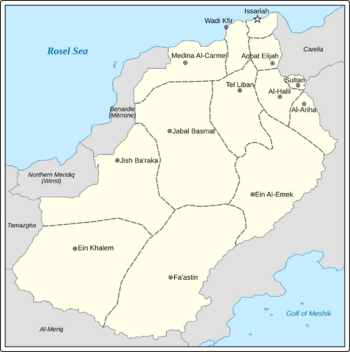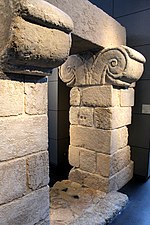Ras al-Khaymah: Difference between revisions
No edit summary |
No edit summary |
||
| (One intermediate revision by the same user not shown) | |||
| Line 129: | Line 129: | ||
|footnotes = <!--For any generic non-numbered footnotes--> | |footnotes = <!--For any generic non-numbered footnotes--> | ||
}} | }} | ||
'''Ras al-Khaymah''' ({{wp|Arabic|Khaymahni}}: رَأْس ٱلْخَيْمَة), officially the State of Ras al-Khaymah ({{wp|Arabic|Khaymahni}}: دولة رَأْس ٱلْخَيْمَة, {{wp|Romanization of Arabic|Romanized}}: Dāwlāţ Rāş āl-Khāymāḩ), commonly shortened to Khaymah in English, is a country in the North [[Meridiq]], bordering [[Carelia]] to the east, the Benardie Territory of [[Meronnia]] to the north, the [[Winst| | '''Ras al-Khaymah''' ({{wp|Arabic|Khaymahni}}: رَأْس ٱلْخَيْمَة), officially the State of Ras al-Khaymah ({{wp|Arabic|Khaymahni}}: دولة رَأْس ٱلْخَيْمَة, {{wp|Romanization of Arabic|Romanized}}: Dāwlāţ Rāş āl-Khāymāḩ), commonly shortened to Khaymah in English, is a country in the North [[Meridiq]], bordering [[Carelia]] to the east, the Benardie Territory of [[Meronnia]] to the north, the [[Winst|Wintonian]] Dominion of Northern Meridiq to the northwest, Tamazgha to the west and Al-Meriq to the south. It is separated from [[Ackesia]] and Amalosia by the Rosel Sea. Geographically it is the largest country in Meridiq and among the largest in the world consisting o the majority of North Meridiq. Most of it's terrain consist of the Khaymahni Desert, various mountain ranges, and Mediterreanan scrubs. Ras al-Khaymah is home to diverse ethnic and religious groups including Khaymahni, Meriqi, and Asqalani and religious groups include Emani, [[Beoin]] and Asqalani Yehudi. Khaymahni consist of the largest ethnic group most of which adhere to the Emani faith. | ||
== History == | == History == | ||
| Line 137: | Line 137: | ||
Prominent cultures during the {{wp|Neolithic period}} include the Al-Awali ({{wp|Arabic|Khaymahni}}: الأول, {{wp|Romanization of Arabic|Romanized}}: Āl-Āwāl) which have developed wide-spread animal domestication of {{wp|goats}}, {{wp|camels}} and {{wp|dogs}} specifically the {{wp|Canaan Dog|Khaymahn Dog}} is thought to have originated in prehistoric Ras al-Khaymah. Much evidence has been gathered from wall painting, stone engravings and statues. These date back 8,000 years ago making them some of the first depictions of dogs in the world. The Al-Awali culture as such is assumed to have been a nomadic husbandry culture that gathered herds of domesticated animals to become self-sufficient on resources while retaining a nomadic travel life. | Prominent cultures during the {{wp|Neolithic period}} include the Al-Awali ({{wp|Arabic|Khaymahni}}: الأول, {{wp|Romanization of Arabic|Romanized}}: Āl-Āwāl) which have developed wide-spread animal domestication of {{wp|goats}}, {{wp|camels}} and {{wp|dogs}} specifically the {{wp|Canaan Dog|Khaymahn Dog}} is thought to have originated in prehistoric Ras al-Khaymah. Much evidence has been gathered from wall painting, stone engravings and statues. These date back 8,000 years ago making them some of the first depictions of dogs in the world. The Al-Awali culture as such is assumed to have been a nomadic husbandry culture that gathered herds of domesticated animals to become self-sufficient on resources while retaining a nomadic travel life. | ||
[[File:Hazor_-_Royal_fortress_gate.jpg|thumb|left|150px|{{wp|Bronze age}} gate]] The earliest sedentary culture can be dated back to 4,000 years ago with the finding of pottery sherds and two metres high burial monuments throughout north Ras Al-Khaymah. It is estimated that the connection through the Khaymahni Desert was cut due to a climatic increase in aridity on the continent during the Bronze age what have lead many of the ancient nomads who reached the Rosel Sea to settle in their place. Alongside pottery early evidence of agriculture and herbal research is found on many wall paintings and stone engraving throughout the coast. The evidence for a sedentary culture was solidifed with the finding of a Brozne age gate that possibly was an entrance to a wealthy family's house. The Bronze age culture of Ras Al-Khaymah is famous for their {{wp|olive oil extraction}} mills found throughout many ancient ruins of early settlements. | [[File:Hazor_-_Royal_fortress_gate.jpg|thumb|left|150px|{{wp|Bronze age}} gate]] The earliest {{wp|sedentary}} culture can be dated back to 4,000 years ago with the finding of pottery sherds and two metres high burial monuments throughout north Ras Al-Khaymah. It is estimated that the connection through the Khaymahni Desert was cut due to a climatic increase in aridity on the continent during the Bronze age what have lead many of the ancient nomads who reached the Rosel Sea to settle in their place. Alongside pottery early evidence of agriculture and herbal research is found on many wall paintings and stone engraving throughout the coast. The evidence for a sedentary culture was solidifed with the finding of a Brozne age gate that possibly was an entrance to a wealthy family's house. The Bronze age culture of Ras Al-Khaymah is famous for their {{wp|olive oil extraction}} mills found throughout many ancient ruins of early settlements. | ||
By 2,000 BC the center of the ancient civilization in Ras al-Khaymah shifted to where today is the capital, [[Issariah]], a shift that is considered by many scholars, the start of the Antiquity era in Ras al-Khaymah. This shift is congregated with many findings of a standarized writing system and official records to the existence of a civilized society on Ras al-Khaymah. | |||
== Etyhmology == | == Etyhmology == | ||
Latest revision as of 18:53, 22 September 2020
The State of Ras al-Khaymah دولة رَأْس ٱلْخَيْمَة Dawlat Ras al-Khaymah | |
|---|---|
|
Flag | |
 | |
| Capital and largest city | Issariah |
| Official languages | Khaymahni |
| Ethnic groups (2016) |
|
| Religion (2016) | 57% Emani 28% Asqalani Yehudi 15% Boein |
| Demonym(s) | Khaymahni |
| Government | Unitary parliamentary constitutional republic |
• President | Ibrahim Suleiman |
• Prime Minister | Rashid al-Attar |
• Speaker of the Parliament | Hussein Diab |
| Legislature | Parliament |
| Population | |
• 2016 estimate | 51,296,679 |
| GDP (PPP) | 2019 estimate |
• Total | $569.80 billion |
• Per capita | $11,108 |
| GDP (nominal) | 2019 estimate |
• Total | $289.98 billion |
• Per capita | $5,653 |
| Gini | high |
| HDI | medium |
| Time zone | UTC-3 |
| Date format | dd-mm-yyyy |
| Driving side | right |
| Calling code | +974 |
| Internet TLD | .kh |
Ras al-Khaymah (Khaymahni: رَأْس ٱلْخَيْمَة), officially the State of Ras al-Khaymah (Khaymahni: دولة رَأْس ٱلْخَيْمَة, Romanized: Dāwlāţ Rāş āl-Khāymāḩ), commonly shortened to Khaymah in English, is a country in the North Meridiq, bordering Carelia to the east, the Benardie Territory of Meronnia to the north, the Wintonian Dominion of Northern Meridiq to the northwest, Tamazgha to the west and Al-Meriq to the south. It is separated from Ackesia and Amalosia by the Rosel Sea. Geographically it is the largest country in Meridiq and among the largest in the world consisting o the majority of North Meridiq. Most of it's terrain consist of the Khaymahni Desert, various mountain ranges, and Mediterreanan scrubs. Ras al-Khaymah is home to diverse ethnic and religious groups including Khaymahni, Meriqi, and Asqalani and religious groups include Emani, Beoin and Asqalani Yehudi. Khaymahni consist of the largest ethnic group most of which adhere to the Emani faith.
History
Prehistory
Evidence of permenant settlements in Ras al-Khaymah range back 125,000 years ago. The earliest manmade marks were in the form of clay and stone tools and ornaments as well as wall paitings. These were dated back to 3 million years ago and mostly resemble a nomadic life-style. Many findings of Oldowan-like sites scattered across common travel routes suggest that Ras al-Khaymah was a prehistoric station for humans migrating north.
Prominent cultures during the Neolithic period include the Al-Awali (Khaymahni: الأول, Romanized: Āl-Āwāl) which have developed wide-spread animal domestication of goats, camels and dogs specifically the Khaymahn Dog is thought to have originated in prehistoric Ras al-Khaymah. Much evidence has been gathered from wall painting, stone engravings and statues. These date back 8,000 years ago making them some of the first depictions of dogs in the world. The Al-Awali culture as such is assumed to have been a nomadic husbandry culture that gathered herds of domesticated animals to become self-sufficient on resources while retaining a nomadic travel life.

The earliest sedentary culture can be dated back to 4,000 years ago with the finding of pottery sherds and two metres high burial monuments throughout north Ras Al-Khaymah. It is estimated that the connection through the Khaymahni Desert was cut due to a climatic increase in aridity on the continent during the Bronze age what have lead many of the ancient nomads who reached the Rosel Sea to settle in their place. Alongside pottery early evidence of agriculture and herbal research is found on many wall paintings and stone engraving throughout the coast. The evidence for a sedentary culture was solidifed with the finding of a Brozne age gate that possibly was an entrance to a wealthy family's house. The Bronze age culture of Ras Al-Khaymah is famous for their olive oil extraction mills found throughout many ancient ruins of early settlements.
By 2,000 BC the center of the ancient civilization in Ras al-Khaymah shifted to where today is the capital, Issariah, a shift that is considered by many scholars, the start of the Antiquity era in Ras al-Khaymah. This shift is congregated with many findings of a standarized writing system and official records to the existence of a civilized society on Ras al-Khaymah.
Etyhmology
The name Ras al-Khaymah translates in English to "Top of the tent". The traces back to the 17th century Ajnabi War, possibly refering to the Al-Qassem dynasty and their leadership in the war. The phrase spread and since then, 18th century records show the Al-Qassem tribe was commonly called as a whole Ras al-Khaymah.
Government and politics
Ras al-Khaymah is a parliamentary democracy with a constitution which sets the legal framework that governs the executive government, legislature and judiciary. The president is the head of state and the prime minister is the head of government. The legislature, the Khaymahni Parliament is elected by the citizens using closed list proportional representation utilzing the D'Hondt method in a single nation-wide constituency for five year terms. From the elected members of Parliament a prime minister is chosen through an appointment vote. The president is elected separately in a nationwide first-past-the-post election for the position for a six year term.
The executive branch known as the cabinet consists of the President, Prime minister and various minor ministers and deputy ministers who hold offices in different administrative realms within the country. Only the president and prime minister are elected while the rest of the ministers are appointed by the prime minister. The executive power is derived directly from the Parliament and its legislatures and therefor the cabinet can be dismissed through a vote of no confidence by the Parliament.
